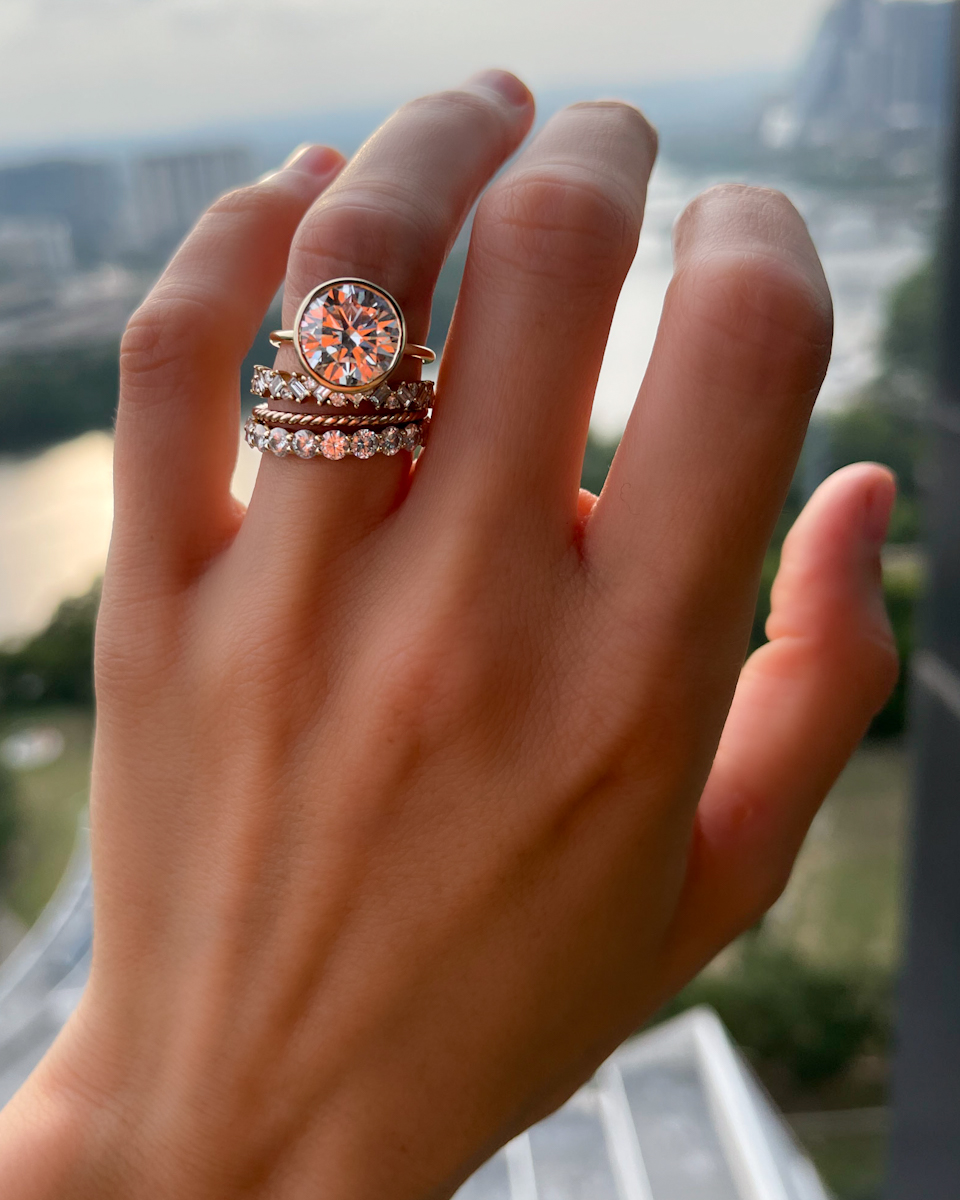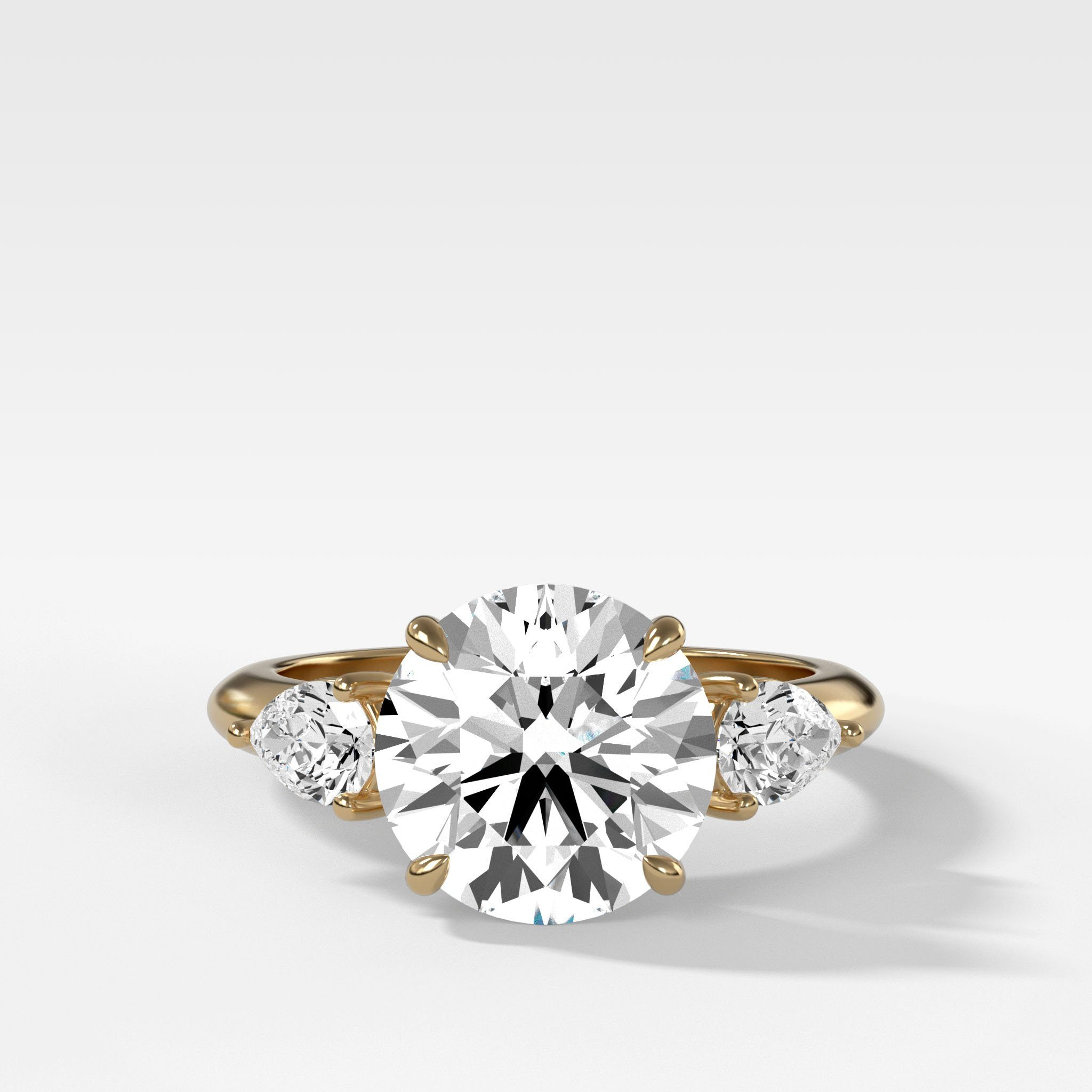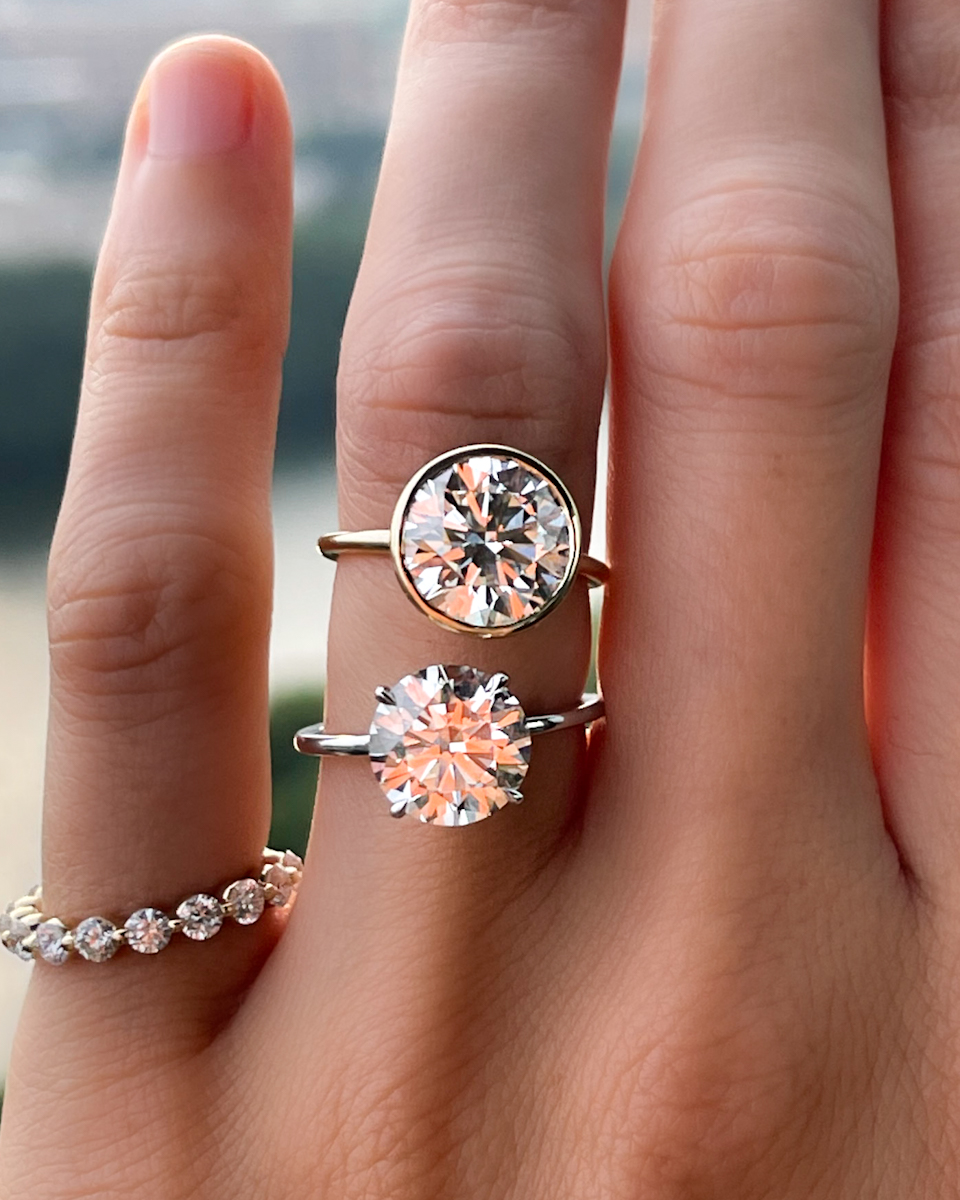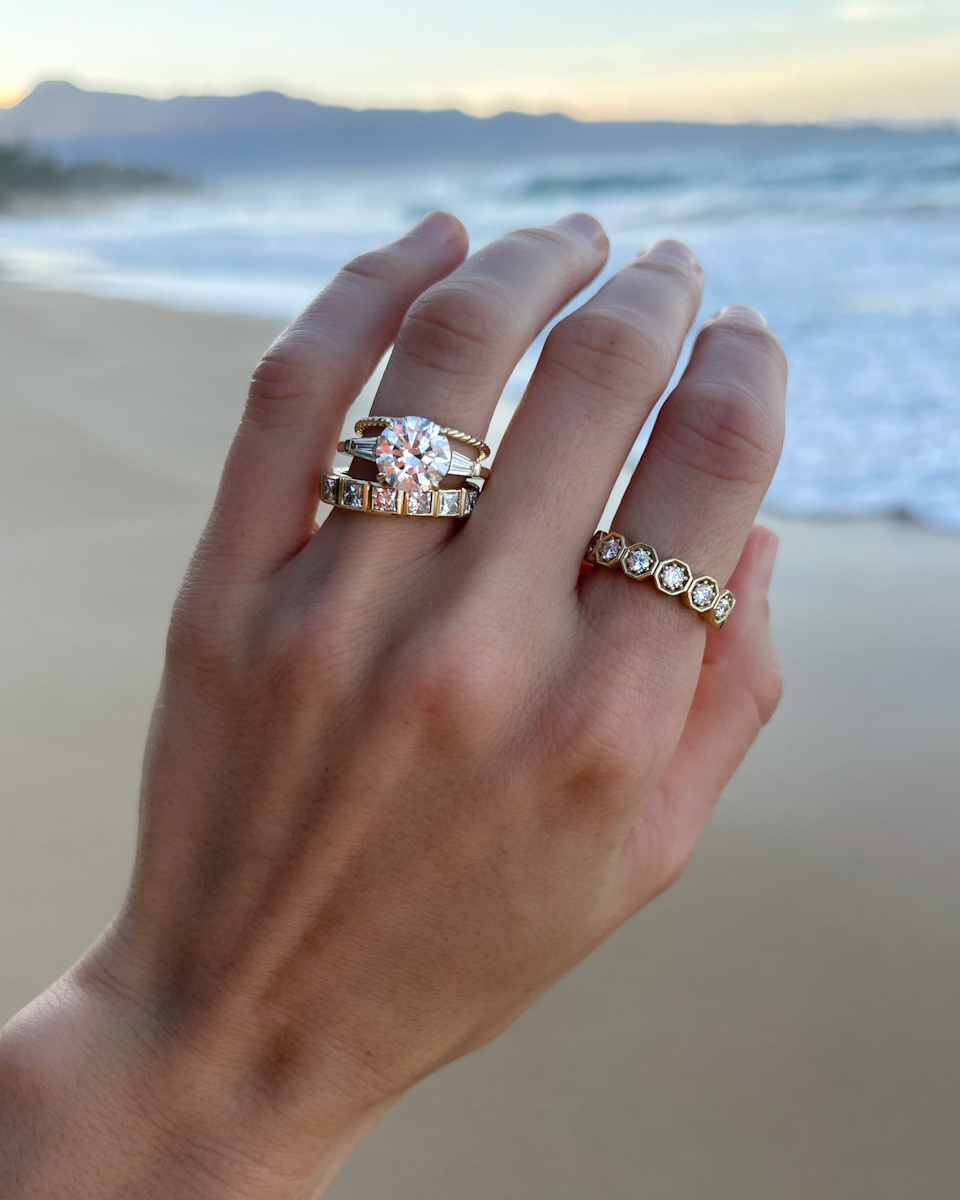If you're on the hunt for the quintessential symbol of your perfect love story, look no further than the timeless brilliance of the round diamond engagement ring. Now, you may or may not already know this, but round diamonds are by far the most popular diamond shape on the market. We don't say this to scare you away, thinking that every other person on the street will have the same ring as you — they won't. But there's good reason for the round engagement ring's lasting popularity and it really comes down to one thing: unsurpassed sparkle.
In a round diamond, you get brilliance and classic design wrapped up in one perfectly symmetrical little package. But there's a lot more to buying a round diamond engagement ring than simply clicking on the next one you see. Of course, you want the one that speaks to you, that shines just so, that flaunts all the engagement ring details you've been looking for. We get that. So here's the roundup on everything you need to know to shop round diamond engagement rings.

Embrace timeless allure with the, Triad Engagement Ring With Round Cut Diamonds.
The Round Diamond Brilliance Revolution
Let's start with a little history lesson, shall we? The round cut diamond, with its mesmerizing sparkle and symmetrical shape, has been captivating hearts for centuries. So, let's set the stage: it's the 17th century, and diamond cutting is still in its infancy. Diamond cutters are experimenting with various shapes and techniques, often aiming to maximize a diamond's size rather than its brilliance. However, as the demand for diamonds grew, so too did the desire for stones that dazzled with light.
The Old European Cut diamond emerged in the late 19th century, during a period of rapid evolution in diamond cutting techniques. It represents a transitional phase between the old-style cushion cuts and the modern round brilliant cuts. Characterized by a smaller table facet, a higher crown, and a larger culet (the facet at the bottom of the diamond), Old European Cut diamonds exude a distinctive charm that harkens back to a bygone era.
Now, you might be wondering, how does the Old European Cut relate to modern round cut diamonds? Well, consider it a distant cousin—similar in shape and structure, yet with its own unique personality. While both cuts share the same round silhouette, the Old European Cut tends to exhibit broader facets and a softer sparkle (they were cut to best reflect candlelight) compared to the precision-engineered brilliance and light return of the modern round brilliant cut.
Despite these differences, both cuts share a common thread: a deep appreciation for the inherent beauty of the diamond itself. Fast forward to the 20th century, and the round diamond experienced a meteoric rise to fame, becoming the most popular choice for engagement rings around the world.
But the modern round brilliant cut diamond, that sparkling gem we know and love today, didn't just materialize out of thin air. Its story is one of innovation, ingenuity, and a relentless pursuit of perfection. Enter Marcel Tolkowsky, a young Belgian mathematician with a passion for diamonds and a knack for numbers.
In 1919, armed with nothing but a pencil, paper, and a whole lot of determination, Tolkowsky penned his groundbreaking thesis, "Diamond Design: A Study of the Reflection and Refraction of Light in Diamond." In this seminal work, Tolkowsky outlined the ideal mathematical proportions and angles necessary to maximize a diamond's brilliance and fire, ultimately giving birth to the modern round brilliant cut diamond. And the rest, as they say, is history.
Thanks to Tolkowsky's genius, and a lot of industry marketing, the round brilliant cut diamond quickly became the gold standard for diamond engagement rings, captivating hearts and minds around the world with its unparalleled sparkle and symmetrical beauty.

A sparkle that has lasted for centuries. Captivate your love story with the modern twist with the, Penumbra Bezel Set Engagement Ring With Round Cut Diamond.
Putting a Round Diamond Ring on It
So, that covers the round diamond itself, but what about the ring? The rise in popularity of diamond engagement rings can be attributed to several factors. One significant factor was the discovery of diamond mines in South Africa in the late 19th century, which led to an increase in the availability of diamonds and a subsequent decrease in their price. This made diamonds more accessible to the general public, rather than being reserved for the wealthy elite.
Another key factor was the marketing efforts of diamond companies, most notably De Beers. In the early 20th century, De Beers launched a highly successful marketing campaign promoting diamonds as symbols of love, romance, and commitment. Their iconic slogan, "A Diamond is Forever," became ingrained in popular culture and solidified the association between diamonds and engagement rings.
Additionally, societal changes, such as the rise of the middle class and the growing emphasis on romantic love and marriage, also contributed to the popularity of diamond engagement rings. By the mid-20th century, diamond engagement rings had become deeply ingrained in Western culture, symbolizing love, commitment, and the promise of a lifetime together. Today, they remain one of the most cherished and enduring symbols of love around the world.
Round Diamonds' Popularity
But just how popular are round cut diamond rings, you ask? Well, let's just say they're the reigning champs of the engagement ring world. Thanks to their timeless appeal and unparalleled sparkle, round diamonds consistently top the charts as the most sought-after shape for engagement rings.
Fancy shaped diamonds, which encompass a wide range of non-round diamond shapes such as princess, emerald, pear, oval, cushion and marquise, have been growing in popularity in recent years, and you can find them adoring the fingers of brides-to-be all across the globe. However, despite the increasing popularity of fancy shaped diamonds, round diamonds still maintain a dominant position in the market, making up about 75% of engagement rings. Ultimately, the choice between a round diamond and a fancy shaped diamond comes down to personal taste and preference. The most important thing is to choose a diamond that speaks to your heart and reflects the love and commitment you share with your partner.

Choose a ring that speaks to you. For a classic and vintage style check out the, Three Stone Engagement Ring With Pear Side Stones With Round Cut Diamond.
Cracking the Code: The 4Cs of Round Diamonds
When it comes to selecting the perfect round diamond, mastering the 4Cs is key. Let's break it down:
Cut:
The cut of a round diamond is what gives it that unparalleled sparkle. In fact, cut is widely regarded as the most important of the 4Cs of diamond grading because it most dramatically influences a diamond's light return and overall beauty. This is particularly true for round brilliant cut diamonds, as they are the only diamond shape that has industry standardized cut grades.
The Gemological Institute of America (GIA), a leading authority on diamond grading and gemological research, introduced the round diamond cut grade in the mid-20th century as part of its efforts to standardize the grading process and provide consumers with more comprehensive information about diamond quality.
Since its introduction, the round diamond cut grade has become an industry standard, adopted by diamond laboratories and gemological institutions around the world. It has also paved the way for the development of cut grading systems for fancy shaped diamonds, although these systems may vary in their approach and methodology.
Round diamonds have a standardized cut grading system primarily because of their unique facet arrangement and symmetrical shape. The round brilliant cut diamond, with its 58 facets meticulously arranged to maximize light return and bounce that sparkle back tot he viewer's eye, has been extensively studied and perfected over the years. This standardized facet arrangement allows for precise measurements and calculations of a diamond's proportions, angles, and light performance.
In contrast, fancy shaped diamonds, such as princess, emerald, pear, and marquise cuts, come in a wide variety of shapes, proportions and facet arrangements. Each fancy shape presents unique challenges and considerations when it comes to evaluating cut quality. Factors such as symmetry, polish, and facet alignment can vary greatly from one fancy shape to another, making it more difficult to establish a standardized cut grading system that applies universally across all shapes, or even from one pear shape to another.
Ultimately, we always recommend purchasing the highest cut grade that your budget allows. You want to look for a round cut diamond with excellent or ideal cut proportions to ensure maximum brilliance. A well cut diamond can also strategically minimize the appearance of inclusions within the diamond, enhance its natural color (or minimize it), and even make the diamond appear larger than its carat weight.
Color:
Diamond color refers to the presence or absence of color in a diamond, which can range from colorless to light yellow or brown. The Gemological Institute of America (GIA) grades diamond color on a scale from D (colorless) to Z (light yellow or brown), with each grade representing a subtle difference in hue and tone. While round diamonds are known for their sparkle, they can also showcase any subtle hints of color. Opt for a diamond with a color grade of G or higher for a bright, white appearance.
Consider the setting style and metal type of the engagement ring when choosing a diamond color, as well. Diamonds set in white gold or platinum settings may appear whiter compared to those set in yellow gold or rose gold settings, as the metal color can influence the perceived color of the diamond. But if you prefer a warmer look, go with a color grade lower on the scale.
Clarity:
Round diamonds are expertly faceted to hide any imperfections, but it's still important to choose a diamond with good clarity to ensure maximum brilliance. Diamond clarity, which refers to the presence of internal and external inclusions and blemishes, is graded on a scale ranging from Flawless (FL) to Included (I), with several subdivisions in between. Flawless or Internally flawless (IF) diamonds are exceptionally rare and expensive. It's a good idea to look for what we call an "eye clean" diamond within a lower clarity grade, which means it won't have inclusions visible to the naked eye, and offers more value.
Ultimately, the choice of diamond clarity depends on personal preference, budget, and the desired balance between clarity and other factors such as size, color, and cut quality. We are happy to help you selec the perfect diamond with the ideal clarity for your needs and preferences.
Carat Weight:
Ah, the age-old question: how big should your diamond be? It's good to remember that carat is simply a measure of a diamond's physical weight, not it's overall size or how that weight is distributed. Hence, why cut is so important. Yet, carat weight is still one of the ways a diamond is priced. All factors considered, choosing a diamond comes down to personal preference and budget, but rest assured that well-cut round diamonds are experts at maximizing carat weight for maximum impact.
Why Choose Round Engagement Ring?
With so many diamond shapes to choose from, why opt for a round diamond? Well, for starters, round diamonds are renowned for their versatility and ability to complement a wide range of styles. Whether you prefer a classic solitaire stone setting or a more intricate halo design, a round diamond is sure to flatter your perfect engagement ring. Plus, the round shape symbolizes eternity and endless love, making it the perfect choice for an engagement ring that stands the test of time.
Modern Round Engagement Rings
While round diamonds are the ultimate classic, there are plenty of ways to wear them that turn your center diamond into a modern marvel. If you're into a solitaire and want to keep things simple, we love the clean lines of a full bezel setting with a round cut diamond shining bright. The gold or platinum wall around the diamond helps to not only keep it protected against active modern lifestyles, but adds a geometric element that styles beautifully with a chunky gold band that's totally on trend.
Dialing it up (or down) a notch, you can go with the club ring, a full-on chunky engagement ring that gives you the look of a bezel but with dainty prongs, and a heftier weight band and basket a or the half-bezel round cut solitaire, which is the ultimate minimalist pick. We love creating a bridal set that reflects the unique love stories of our clients, so mix and match to your heart's content!

A side by side comparison of the Thin + Simple Solitaire Engagement Ring With Round Brilliant Cut Diamond and a Penumbra Bezel Set Engagement Ring With Round Cut Diamond.
Classic Round Engagement Rings
If you want something that's a bit more classic in your round cut ring, a tapered baguette three-stone engagement ring is the number one pick. It adds side stones with a traditional look combined with the intense sparkle of the round diamond center stone. But you can also change it up a bit with pear side stones that will stand the test of time for generations to come. These three-stone styles from our collection wouldn't be complete without our Triad Engagement Ring, which strikes a balance between traditional and modern looks with a three-stone style that flanks your center diamond with two just-barely-smaller round diamonds, one on each side. Pair any of these with a round diamond wedding band for good measure, and see your bridal set dreams come true.

For a classic touch in your round cut ring, opt for a Translunar Tapered Baguette Engagement Ring With Round Cut Diamond —the ultimate choice blending tradition with the dazzling sparkle of a round diamond center stone.
Pricing
As for pricing, round diamonds do tend to command a premium compared to other shapes due to their popularity and the fact that more rough diamond material is lost during the cutting process to achieve that perfect round shape. However, fear not! With a little savvy shopping and an understanding of the 4Cs (cut, color, clarity, and carat weight), you can find a round diamond that fits both your style and budget.
You can also consider purchasing a lab grown diamond instead. Offering the exacting standards of beauty and brilliance you know at about half the cost of a mined diamond, lab grown diamonds can save you considerably on the price of your engagement ring.
Round and Round You Go
With their timeless style, unmatched sparkle, and endless versatility, it's no wonder that round engagement rings continue to capture the hearts of couples around the globe. So, whether you're planning a romantic proposal or simply dreaming of your future sparkler, discover our full collection and find your favorites today! After all, when it comes time to express your love, why settle for anything less than perfection?











Leave a comment (all fields required)